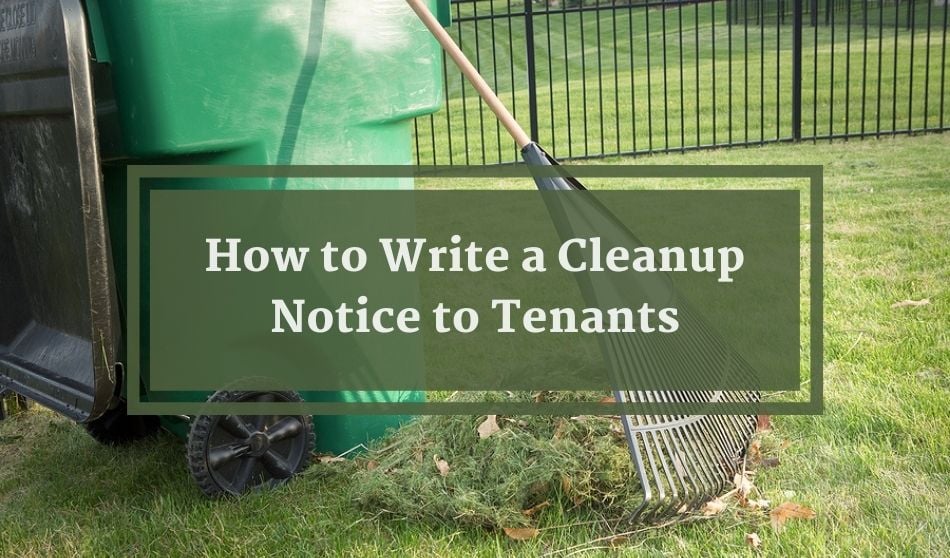
A cleanup notice is a friendly way to communicate with your tenants your expectations on the upkeep of a rental. We all have different ideas of what it means to be tidy, and your renters are no exception. A good rental cleanup notice can effectively communicate your standards and expectations and help get cooperation and renter compliance before things escalate.
The Importance of a Cleanup Notice
The importance of a cleanup notice can’t be overstated. A rental cleanup letter opens the channels of communications, provides important information about expectations, can help build a good tenant-landlord relationship, and address a concern before it becomes a problem.
Of course you care about your rental general upkeep of the grounds and property and the curb appeal and the good image in the neighborhood. But an often overlooked motivator for crafting a cleanup notice is to help keep the property and tenants safe from hazards.
Landlords are required to provide a warranty of habitable conditions to ensure renters have a safe place to live – but it’s a partnership in that tenants need to do their part to help maintain the rental property to help avoid:
Safety Hazards
Items not stored properly create tripping hazards or can potentially cause other injury. Items like bikes, lawn hoses, ladders, and extraneous boxes can clutter a clear walking path. How items are stored can be a cause for concern for items falling and causing harm.
Health Hazards
From pet waste not picked up to toxic material that a child or pet could access need to be addressed as soon as possible. Same is true for consistent habits to control mold and mildew and removal of garbage. These situations left unattended can contribute to pest infestations, mold and mildew damage, and can even cause injury and be deadly.
Fire Hazards
Many safety and health hazards also fall into this category. But specifically, stacked boxes and paper clutter that is beyond the norm, covering vents with clutter, not degreasing a stove vent are all potential fire hazards.
*These hazards may warrant an immediate and more formal lease violation at your discretion.
Before You Write Your First Cleanup Letter
Your mindset and approach is vital. The main goal is to foster cooperation while maintaining a good relationship with your renters. If you’ve done a home inspection or noticed something askew on a drive-by, how you communicate the improvements and changes you expect may just be the difference between getting cooperation vs needing to escalate to the next level.
But before you can communicate those expectations, they can’t just come unexpectedly but rather from the rules and standards built into your lease and rental agreements, addendums, and other documentation.
Setting the standard for cleanliness needs to be based on clearly defined expectations. For example:
- How many bikes, yard toys, yard art/décor, plants can the renter have on the property and how should they be stored or displayed.
- What type of outdoor patio furniture allowed. For example: are camping chairs or dining room furniture acceptable on the porch or must it be designated patio furniture?
- Will you allow barbeque grills and if so, what type. What about fire pits or propane outdoor heaters?
It’s important to not only think about your preferences (because it is your asset after all) but to also discuss these issues with your insurance carrier. You wouldn’t want to allow certain items if the damage they might cause isn’t covered in your landlord insurance policy.
After consideration, give every tenant a copy of the approved items allowed as well as a list of unacceptable items so there isn’t any confusion. In that list, you’ll also want to include what items that should be stored away (and how you’d like them stored) such as car batteries, gas cans, cleaning supplies, ladders, hoses, etc.. for hazard prevention.
Be sure to include in your lease or rental agreement your right to conduct property inspections with property notice at any time. That way, you’ll be able to deal with any concerns such as neighbor complaints of insects and bugs, strange odors, etc
Lastly, check with your state and local regulations on types of letters and notices you are required to give if you need to escalate past the friendly cleanup notice.
What Goes Into a Cleanup Notice
A great question to ask yourself is: Does this situation warrant a friendly cleanup notice or is a lease violation notice more appropriate?
Although a cleanup notice is similar to a violation notice, the cleanup letter is informal and doesn’t carry the same weight. A violation notice conveys a serious tone to highlight the severity of the issue whereas a cleanup notice is basically giving the tenant the benefit of the doubt and an opportunity to remedy the situation before you take further action. But both require similar information:
Include the basics like their name, address, unit number, landlord/your name, date, and contact information.
Be friendly and courteous. You get more bees with honey! You never know what your tenant is dealing with at any given moment such as the death of a friend or family member, health issues, etc which can disrupt normal housekeeping routines and habits. Giving the tenant the benefit of the doubt with a kindly written letter can go far in helping get the cooperation you’re seeking.
In fact, you might want to start with a simple sentence that conveys that you understand that life can get overwhelming and busy but you noticed a few things you’d like to point out to bring to their attention.
Address the issue by outlining the specific concern, what they need to do to remedy, how it could be a hazard or harm, as well as how it might violate lease clauses and/or rules and regulations. It’s good here to reference the lease terms and their agreement to that standard of cleanliness when they began their tenancy. Sometimes it’s helpful to include a copy of that lease page/paragraph with the clause highlighted.
Note the deadline and consequences if not remedied. Depending on the type of letter, add a deadline with the date of a follow-up inspection appointment set for the day after your deadline (or when best suits your schedule). If it’s a friendly letter or conversation, this could be a simple note to say you’ll be checking back within a certain period of time.
Ideas to Help Cleanup Compliance
You can also offer in your letter suggestions on how they can remedy a situation by providing information to helpful resources. Ask if there is anything you might be able to do to help and offer that they are welcome to communicate with you if they are having difficulties.
Automation can make it easy on yourself by using your landlord software tools. Create templates in your software to keep handy that are an easy click to autofill with the particulars and attach any photo and email it off to the tenant. Or you could upload a cleanup notice and pictures and share it to their tenant portal for reference and easy access. These days, tech-savvy tenants may appreciate having a digital copy vs the traditional letter in the mailbox.
Automation can also be a benefit if sending a more serious infraction notice. Which brings us to what to do when a cleanup request becomes more serious.
Signs it’s Time to Escalate
If the deadline comes and goes or the situation is clearly a violation that needs immediate attention it may require a more serious approach. That means, it’s time to follow through with the consequences such as fines and fees, a formal notice of the lease violation, and/or potentially starting an eviction process.
If it’s a health and safety issue, you may even need to call on outside authorities such as public safety, fire marshal, etc.
If you see signs of hoarding, this is a delicate situation that requires care.
You can find some great tips on handling a hoarding problem here:
What Landlords and Tenants Need to Know About Hoarding vs Clutter
Final Considerations
If it becomes a habit, it might be necessary to choose not to renew their lease or proceed to court for an eviction for lease violations. Because things can escalate, it’s important to keep all documentation. That may mean logging every conversation into the tenant notes in your property management software, saving copies of all letters sent and replies received. You might need to even send formal notices through a certified mail service (based on your state regulations).
Remember, for any eviction case seek legal advice and check with your local and state regulations before you start the process. It’s important to note whether it’s a first infraction, a small matter, or large violation, you do have to give them the opportunity to correct the situation.
Be clear in your correspondence that they are in breach of their lease or rental agreement. In a friendly cleanup notice choose your wording to convey that they may have inadvertently overlooked the concern. You can be more direct in your next communication if they ignore the request.
Getting cooperation starts with your approach by keeping clean lines of communication open in a friendly, helpful manner.






very useful article, thanks to the author